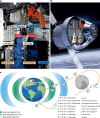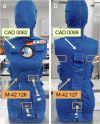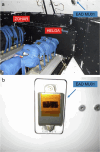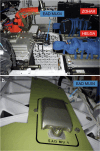Space radiation measurements during the Artemis I lunar mission
- PMID: 39294379
- PMCID: PMC11446838
- DOI: 10.1038/s41586-024-07927-7
Space radiation measurements during the Artemis I lunar mission
Abstract
Space radiation is a notable hazard for long-duration human spaceflight1. Associated risks include cancer, cataracts, degenerative diseases2 and tissue reactions from large, acute exposures3. Space radiation originates from diverse sources, including galactic cosmic rays4, trapped-particle (Van Allen) belts5 and solar-particle events6. Previous radiation data are from the International Space Station and the Space Shuttle in low-Earth orbit protected by heavy shielding and Earth's magnetic field7,8 and lightly shielded interplanetary robotic probes such as Mars Science Laboratory and Lunar Reconnaissance Orbiter9,10. Limited data from the Apollo missions11-13 and ground measurements with substantial caveats are also available14. Here we report radiation measurements from the heavily shielded Orion spacecraft on the uncrewed Artemis I lunar mission. At differing shielding locations inside the vehicle, a fourfold difference in dose rates was observed during proton-belt passes that are similar to large, reference solar-particle events. Interplanetary cosmic-ray dose equivalent rates in Orion were as much as 60% lower than previous observations9. Furthermore, a change in orientation of the spacecraft during the proton-belt transit resulted in a reduction of radiation dose rates of around 50%. These measurements validate the Orion for future crewed exploration and inform future human spaceflight mission design.
© 2024. The Author(s).
Conflict of interest statement
The authors declare no competing interests.
Figures











References
-
- Sishc, B. J. et al. The need for biological countermeasures to mitigate the risk of space radiation-induced carcinogenesis, cardiovascular disease, and central nervous system deficiencies. Life Sci. Space Res.35, 4–8 (2022). - PubMed
-
- Parsons, J. L. & Townsend, L. W. Interplanetary crew dose rates for the August 1972 solar particle event. Radiat. Res.153, 729–733 (2000). - PubMed
-
- Mewaldt, R. A. et al. Record-setting cosmic-ray intensities in 2009 and 2010. Astrophys. J. Lett723, L1 (2010).
-
- Selesnick, R. S., Baker, D. N., Kanekal, S. G., Hoxie, V. C. & Li, X. Modeling the proton radiation belt with Van Allen Probes relativistic electron-proton telescope data. J. Geophys. Res. Space Phys.123, 685–697 (2018).
MeSH terms
Substances
LinkOut - more resources
Full Text Sources
Miscellaneous

